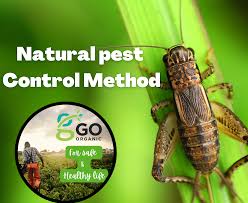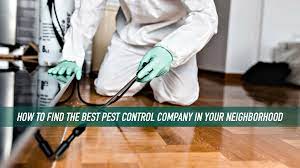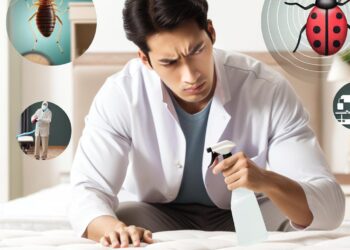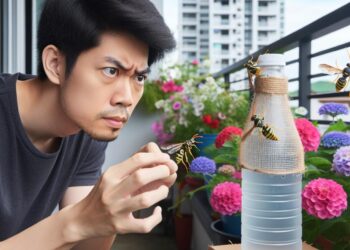Introduction:
Pest infestations can be a nuisance in any building, and different types of structures require different approaches to pest control. High-rise buildings present unique challenges due to their height and density, while single-family homes require tailored solutions to suit their size and layout. In this article, we will review the most effective pest control products and methods for different types of structures, with a focus on high-rise buildings and single-family homes.
Pest Control Products and Methods for High-rise Buildings:
- Exterior pest control treatments: This involves the application of pest control products on the exterior of the building to create a barrier that prevents pests from entering. This method is particularly effective for high-rise buildings since pests can easily enter through balconies, windows, and other openings. Pest control professionals use specialized equipment such as cherry pickers to reach high levels of the building.

Source: Google Images - Baiting systems: These systems use bait stations strategically placed around the building to attract and trap pests such as rodents and ants. The bait used in these stations is usually toxic to the pest, which then dies or is unable to reproduce, ultimately reducing the pest population.
- Insecticides: Insecticides are chemicals that kill insects. These are often used in high-rise buildings, especially for controlling cockroach infestations. Pest control professionals apply insecticides in specific areas such as cracks and crevices, where cockroaches hide.
Pest Control Products and Methods for Single-family Homes:
- Integrated Pest Management (IPM): IPM is a holistic approach to pest control that combines different methods to control pests effectively. This method uses techniques such as sanitation, pest exclusion, and mechanical controls to prevent and manage pest infestations.
- Traps: Traps are devices that capture pests such as rodents and insects. There are various types of traps, including snap traps, glue traps, and live traps. Pest control professionals may also use pheromone traps, which use the pests’ natural attraction to a specific scent to lure them to the trap.
- Natural pest control methods: Natural pest control methods such as essential oils, diatomaceous earth, and borax are gaining popularity in single-family homes. These products are effective at controlling pests such as ants, fleas, and bed bugs without posing a risk to humans or pets.

Pest control is an ongoing process that requires regular inspections, monitoring, and preventative measures to prevent future infestations. By identifying and addressing pest problems early, you can save yourself time, money, and potential health risks associated with pests.
In addition to using the right pest control products and methods, it’s essential to practice good hygiene habits and eliminate pest attractants such as food debris, standing water, and clutter. By removing these attractants, you can make your structure less appealing to pests, reducing the likelihood of infestations.
When choosing a pest control company, it’s important to look for a company with a proven track record of success, licensed and insured, and use environmentally friendly pest control methods. A good pest control company should also provide ongoing monitoring and maintenance to ensure long-term pest control effectiveness.
It’s also essential to communicate with your pest control professional about any specific concerns or preferences you may have regarding pest control products and methods. For example, if you have pets or children, you may prefer to use natural pest control products that are safe for your family and pets.

Effective pest control is crucial for maintaining a safe and healthy living environment. By choosing the right pest control products and methods for your structure and working with a professional pest control company, you can prevent and manage pest infestations effectively. Regular inspections, monitoring, and good hygiene habits are also essential for preventing future pest problems. By taking these steps, you can enjoy a pest-free home or building and peace of mind knowing that you have taken the necessary steps to protect your health and property.
It’s also important to keep in mind that pests can cause significant damage to structures, furniture, and other belongings. For example, termites can cause extensive damage to wooden structures, while rodents can chew through wires and cause electrical fires. Bed bugs can also be a significant nuisance, causing bites and infesting bedding and furniture.
If you suspect a pest problem in your structure, it’s essential to act quickly and seek professional pest control services. Delaying pest control can lead to more significant pest populations, making it more challenging and expensive to control them.
It’s also important to be aware of the potential health risks associated with pests. Pests such as cockroaches and rodents can carry diseases and allergens that can be harmful to humans. For example, cockroaches can trigger asthma and allergies, while rodents can spread diseases such as salmonella and hantavirus.
By taking a proactive approach to pest control and working with a professional pest control company, you can protect yourself, your family, and your property from the potential risks associated with pests.
Let’s take a closer look at some of the most effective pest control products and methods for different types of structures.
High-Rise Buildings:
High-rise buildings present unique challenges for pest control due to their size, complexity, and shared spaces. It’s essential to work with a pest control company that has experience dealing with high-rise buildings and can provide customized solutions to meet the unique needs of each building.
One effective pest control method for high-rise buildings is the use of Integrated Pest Management (IPM). IPM is a holistic approach to pest control that focuses on prevention, monitoring, and using the least toxic pest control products when necessary. By incorporating IPM practices into their pest control strategies, pest control professionals can reduce the likelihood of pest infestations and minimize the need for chemical pesticides.
Another effective pest control method for high-rise buildings is the use of bait stations. Bait stations are small, discreet containers that contain bait and a toxic pesticide. They are strategically placed in areas where pests are likely to travel, such as along walls and in corners. Bait stations are an effective way to control pest populations without the need for sprays or other types of pesticides.
Single-Family Homes:
Single-family homes are typically smaller and less complex than high-rise buildings, making them easier to control and monitor for pest infestations. However, they still require regular inspections and preventative measures to keep pests at bay.

One effective pest control method for single-family homes is the use of exclusion techniques. Exclusion techniques involve sealing up potential entry points for pests, such as gaps around doors and windows, holes in walls and floors, and cracks in foundations. By sealing up these entry points, you can prevent pests from entering your home in the first place.
Conclusion
Effective pest control is essential for maintaining a healthy and safe living environment in any structure, whether it’s a high-rise building or a single-family home. By choosing the right pest control products and methods, practicing good hygiene habits, and working with a professional pest control company, you can prevent and manage pest infestations effectively. Remember to act quickly if you suspect a pest problem and be aware of the potential health risks associated with pests. With the right approach to pest control, you can enjoy a pest-free home or building and peace of mind knowing that you have taken the necessary steps to protect your health and property.















